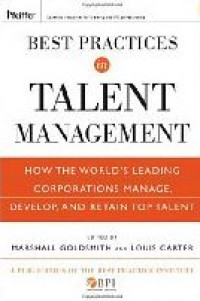
Best practices in talent management : how the world`s leading corporations manage, develop, and retain top talent
| Gmd : Text
| Availability :
| 00000011380 | HD30.4 .B483 2010 | (General Book) | Available - Ada |
| 00000011382 | HD30.4 .B483 2010 | (General Book) | Available - Ada |
The purpose of this best practices handbook is to provide you with the most current and necessary elements and practical "how-to" advice on how to implement a best practice talent management program within your organization. The handbook was created to provide you with a current 21st century snapshot of the world of talent management today. It serves as a learning ground for organization and social systems of all sizes and types to begin attracting, retaining, and motivating top talent through more employee-and customer-centered programs that emphasize consensus building; self-group, organizational, and one-on-one awareness and effective communication; clear connections to overall business objectives; and quantifiable business results. Contributing organizations in this book are widely recognized as among the best in organization change and leadership development today. They provide invaluable lessons in succeeding during crisis or growth modes and economies. As best practice organizational champions, they share many similar attributes, including openness to learning and collaboration, humility, innovation and creativity, integrity, a high regard for people's needs and perspectives, and a passion for change. Most of all, these are the organizations that have invested in human capital, the most important asset inside of organizations today. And these are the organizations that have spent on average $1M on talent management, an average of $2M over the course of their program, with an average rate of return on investment of over $5M.
Within the forthcoming chapters, you will learn from our world's best organizations in various industries and sizes:
*Key elements of leading successful, results-driven talent management; tools, models, instruments, and strategies for leading talent management; practical "how-to" approaches to diagnosing, assesing, designing, implementing, coaching, following-up on, and evaluating talent management; and critical success factors and critical failure factors, among others.
Within each case study in this book, you will learn how to:
1. Analyze the need for the specific talent management program;
2. Build a business case for talent management
3. Identify the audience for the prgram;
4. Design the program;
5. Implement the design for the program; and
6. Evaluate the effectiveness of the program.
| Series Title |
-
|
|---|---|
| Call Number |
HD30.4 .B483 2010
|
| Publisher Place | Hoboken |
| Collation |
xxx, 303p.; 25cm.
|
| Language |
English
|
| ISBN/ISSN |
9780470499610
|
| Classification |
HD30.4
|
| Media Type |
-
|
|---|---|
| Carrier Type |
-
|
| Edition |
-
|
| Subject(s) | |
| Specific Info |
-
|
| Statement |
-
|
| Content Type |
-
|
No other version available







